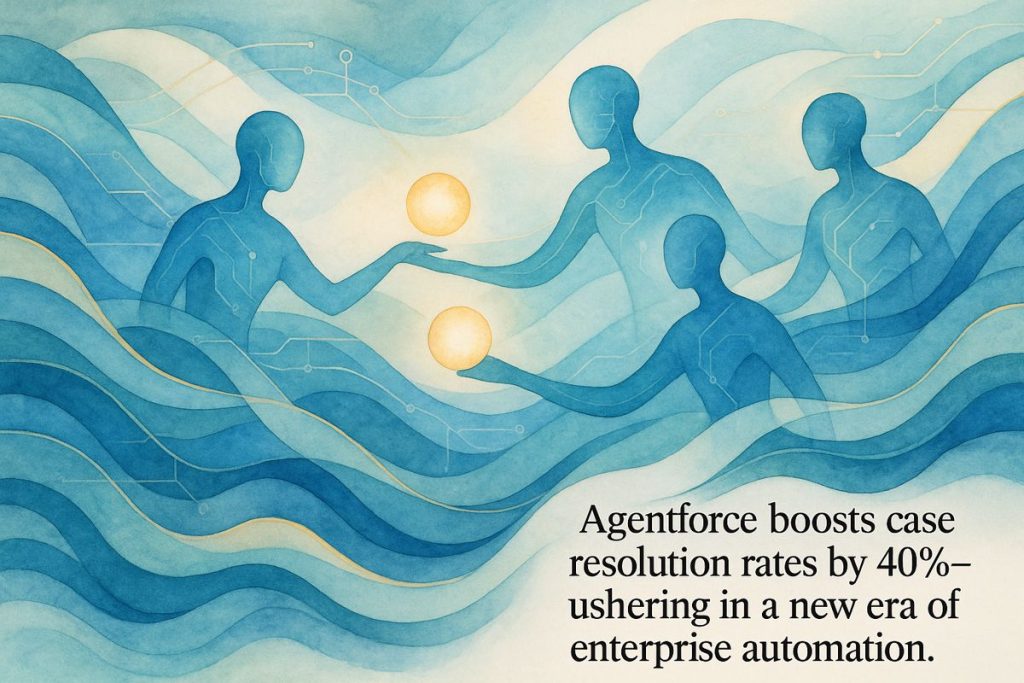Salesforce Agentforce is a powerful new AI platform designed to automate tough business tasks inside Salesforce. It uses the smart Atlas Reasoning Engine to break down complex jobs, making work easier and faster for sales, support, and marketing teams. With simple tools, anyone can build AI agents or pick from ready-made ones in the AgentExchange marketplace. Big companies are already seeing big improvements, like faster customer help and smoother workflows. Agentforce is shaking up the old way of doing things—making businesses more efficient and ready for the future.
What is Salesforce Agentforce and how does it transform enterprise AI automation?
Salesforce Agentforce is an advanced AI platform designed to automate complex enterprise workflows within the Salesforce ecosystem. Powered by the Atlas Reasoning Engine, it enables organizations to create, deploy, and share AI agents that streamline sales, support, and marketing—improving efficiency, compliance, and customer experience.
A New Species in the Salesforce Savanna
There’s something almost mythic about the launch of Salesforce Agentforce. Picture this: October 2024, caffeine-fueled product managers and engineers at Salesforce lighting up dashboards as their newest AI platform—Agentforce—goes live. I can still recall the scent of burnt espresso from my own office that day, as I tried, somewhat skeptically, to wrangle the documentation. The promise? To empower enterprises to conjure up AI agents that actually do the work—not just talk about it—in the familiar, sprawling Salesforce ecosystem. The sheer audacity is unmistakable.
This isn’t just another chatbot in a cheap suit. No, Agentforce is engineered for complexity, automating the labyrinthine workflows of sales, customer support, and marketing, all while respecting the hyperspectral compliance requirements of regulated industries like pharma and life sciences. Imagine an agent deftly orchestrating omnichannel engagement across voice, email, chat, and whatever telepathic protocol we invent next (okay, not yet, but give it ten years). Salesforce is clearly intent on making the phrase “business as usual” obsolete.
Regulation is no mere afterthought: for companies like Wiley, Accenture, and The Adecco Group—proper nouns that have become veritable palimpsests of digital transformation—robust data governance and traceability aren’t optional, they’re existential. I had to stop and ask myself: Will Agentforce bring more order or just another layer of delightful chaos? The jury’s out, but let’s continue.
The Atlas Reasoning Engine: Brains Behind the Curtain
What truly separates Agentforce from the lumbering chatbots of yesteryear is its AI core, the Atlas Reasoning Engine. This isn’t your cousin’s if-this-then-that macro. Atlas deconstructs gnarly requests into digestible tasks, selects optimal actions, and spins up execution plans as if playing four-dimensional chess. The engine intuits user intent, matching it with an almost eerie precision to the right agent topic—think of it as an orchestra conductor who can also sight-read the audience’s mood.
Integration with Salesforce’s Customer 360 suite means that Agentforce isn’t some siloed automaton. It’s got its fingers—metaphorically speaking—in every pie: CRM, Slack, Tableau, and even soon, Google Cloud (the latter on Salesforce’s roadmap for later in 2025). I can hear the whir of data pipelines and the click of real-time dashboards updating. With Tableau integration landing in December 2024, Slack by January 2025, and the aforementioned cloud compatibility, the platform’s reach is nothing short of rhizomatic.
One minor confession: my first dance with Atlas was clumsy. I mistook its suggestive prompts for hard constraints—rookie error. Thankfully, Agentforce is forgiving, and with a little trial, error, and a dash of humility, I learned to trust the system’s recommendations. This iterative feedback loop—equal parts frustration and “aha!” moments—is a feature, not a bug.
Building, Tinkering, and Sharing Agents: From Sketch to Showroom
Salesforce hasn’t just built a platform—they’ve handed us the keys to the kingdom (okay, maybe just a guest pass). Agent Builder, their low-code design tool, lets mere mortals as well as apex developers craft agents. Just describe what you need—in natural language, no less—and the builder transmutes your wish into a functional agent. It’s as if SQL met the Genie from Aladdin, only with fewer side effects.
Developers with a penchant for experimentation can dive into the Agentforce Developer Edition: a free sandbox where prototypes collide with reality. This environment, deeply married to Data Cloud, lets you explore Salesforce datasets with reckless abandon—or cautious precision, depending on your mood. I’ll admit: there’s a particular tactile pleasure in dragging and dropping logic blocks, like kneading bread dough, only with more variables and less mess.
And then there’s AgentExchange, Salesforce’s marketplace for pre-built agents and skills. Think AppExchange but for AI labor. You need a GDPR-compliant data retrieval agent? Search, download, deploy. Bam! The communal aspect here is compelling; it’s almost like a bazaar where code meets commerce, and everyone’s hawking their brightest AI offspring.
Real Impact: From Frustration to Flow
Let’s cut through the hype—does Agentforce actually deliver? The evidence is mounting. Wiley, for instance, rolled it out before the notorious back-to-school rush and saw case resolution rates jump by 40% over their old chatbot. That’s not a rounding error; it’s a tectonic shift. Imagine the collective sigh of relief from students and faculty when the AI agent responds in seconds, not hours.
And it’s not just academia. Heavyweights like IBM, Indeed, SharkNinja, and Finnair are weaving Agentforce into the fabric of their operations. Early users of Agentforce 2dx (the platform’s proactive, background-operating evolution), including OpenTable and the Oregon Humane Society, are automating everything from customer onboarding to pet adoption follow-ups. There’s a whiff of optimism in the air—mixed, of course, with the tang of ongoing skepticism.
Salesforce’s own research is a damning indictment of the status quo: American consumers waste up to nine hours wrestling with customer service per issue, with 67% reporting exasperation when forced to wait. A full third abandon the process entirely. Agentforce’s automated triage, diagnostic, and escalation tools promise to flip this script—though, I’ll admit, I’ll believe it when I see it at scale.
Enablement, Experimentation, and the Path Ahead
To grease the wheels of adoption, Salesforce has spun up
